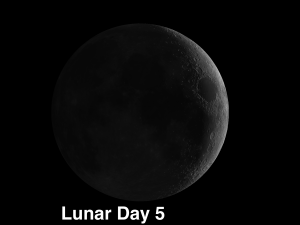The week of November 28 – December 4 takes us from Lunar Day 26 (essentially New Moon) to the beginning of Day 5. This week we will highlight the craters Peirce and Picard visible on Friday and Mare Nectaris visible on Saturday & Sunday.

Peirce & Picard: [NE/H15] The two largest intact craters on Mare Crisium are Peirce and Picard. They are only about 12 miles in diameter by 1 mile deep and will require 75x – 100x to see them. They are located on a more-or-less north-south line about 30 miles in from the western shore of Crisium (Peirce is the northernmost). The lava that covered Crisium stopped flowing before these craters formed. You should easily be able to spot Swift, a small seven-mile crater just eight miles to the north of Peirce.
 Mare Nectaris: [SE/L13] The Nectaris basin was excavated 3.9 billion years ago. The oldest features on the Moon formed prior to this event. Mare Nectaris is a classic example of a multi-ring basin. Sunday night will reveal Rupes Altai, a high cliff that is a conspicuous fragment of one of the original rings. As daylight moves across the region, try to locate hints of other ring features surrounding Mare Nectaris.
Mare Nectaris: [SE/L13] The Nectaris basin was excavated 3.9 billion years ago. The oldest features on the Moon formed prior to this event. Mare Nectaris is a classic example of a multi-ring basin. Sunday night will reveal Rupes Altai, a high cliff that is a conspicuous fragment of one of the original rings. As daylight moves across the region, try to locate hints of other ring features surrounding Mare Nectaris.
OF ADDITIONAL INTEREST ON LUNAR DAYS 26 – 5:
Scan the south-western horizon about 15 minutes after local sunset, and you will see something that the great Copernicus himself never saw, the planet Mercury, with the Moon to Mercury’s right (or upper right, depending on your location).
======================
It is highly recommended that you get a copy of Sky and Telescope’s Field Map of the Moon, the very finest Moon map available for use at the telescope. It is available for $10.95 at www.skyandtelescope.com and on Amazon. All features mentioned in this blog will be keyed to the grid on the Field Map and will look like this: Plato: [NW/D9]
Credits:
Courtesy of Gray Photography of Corpus Christi, Texas
Lunar photos: NASA / USGS / BMDO / LROC / ASU / DLR / LOLA / Moon Globe. Used by permission
- Rupes Cauchy: A Best Known Fault on the Moon - July 22, 2024
- Moon Crater Schickard – Crater Floor has Stripes - July 15, 2024
- Moon Craters Langrenus and Vandelinus - July 8, 2024